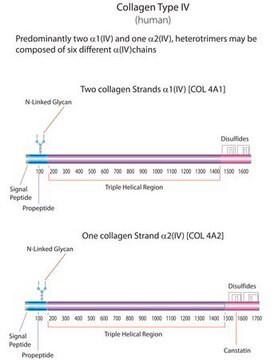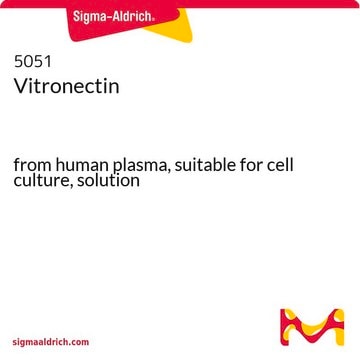CC080
Human Vitronectin
from human plasma, liquid, 1 mg/mL, suitable for cell culture
Synonim(y):
S-protein
About This Item
Polecane produkty
product name
Vitronectin, Human Purified Protein,
pochodzenie biologiczne
human
Poziom jakości
Próba
≥90% (SDS-PAGE)
Postać
liquid
aktywność właściwa
1 μg/mL (cell attachment assays)
producent / nazwa handlowa
Chemicon®
stężenie
1 mg/mL
metody
cell culture | mammalian: suitable
moc wejściowa
sample type hematopoietic stem cell(s)
sample type mesenchymal stem cell(s)
sample type: human embryonic stem cell(s)
sample type pancreatic stem cell(s)
sample type epithelial cells
sample type induced pluripotent stem cell(s)
sample type neural stem cell(s)
numer dostępu NCBI
numer dostępu UniProt
Warunki transportu
dry ice
temp. przechowywania
−70°C
informacje o genach
human ... VTN(7448)
Powiązane kategorie
Opis ogólny
Binds to heparin. Active in cell attachment of MG63 cells.
Zastosowanie
Powiązanie
Postać fizyczna
Przechowywanie i stabilność
During shipment, small volumes of product will occasionally become entrapped in the seal of the product vial. For products with volumes of 200μL or less, we recommend gently tapping the vial on a hard surface or briefly centrifuging the vial in a tabletop centrifuge to dislodge any liquid in the container′s cap.
Komentarz do analizy
Informacje prawne
Oświadczenie o zrzeczeniu się odpowiedzialności
Kod klasy składowania
12 - Non Combustible Liquids
Klasa zagrożenia wodnego (WGK)
WGK 2
Temperatura zapłonu (°F)
Not applicable
Temperatura zapłonu (°C)
Not applicable
Certyfikaty analizy (CoA)
Poszukaj Certyfikaty analizy (CoA), wpisując numer partii/serii produktów. Numery serii i partii można znaleźć na etykiecie produktu po słowach „seria” lub „partia”.
Masz już ten produkt?
Dokumenty związane z niedawno zakupionymi produktami zostały zamieszczone w Bibliotece dokumentów.
Protokoły
Ta strona obejmuje protokoły powlekania ECM opracowane dla czterech rodzajów ECM na wkładkach Millicell®-CM, kolagenu typu 1, fibronektyny, lamininy i matrigelu.
This page covers the ECM coating protocols developed for four types of ECMs on Millicell®-CM inserts, Collagen Type 1, Fibronectin, Laminin, and Matrigel.
Nasz zespół naukowców ma doświadczenie we wszystkich obszarach badań, w tym w naukach przyrodniczych, materiałoznawstwie, syntezie chemicznej, chromatografii, analityce i wielu innych dziedzinach.
Skontaktuj się z zespołem ds. pomocy technicznej








